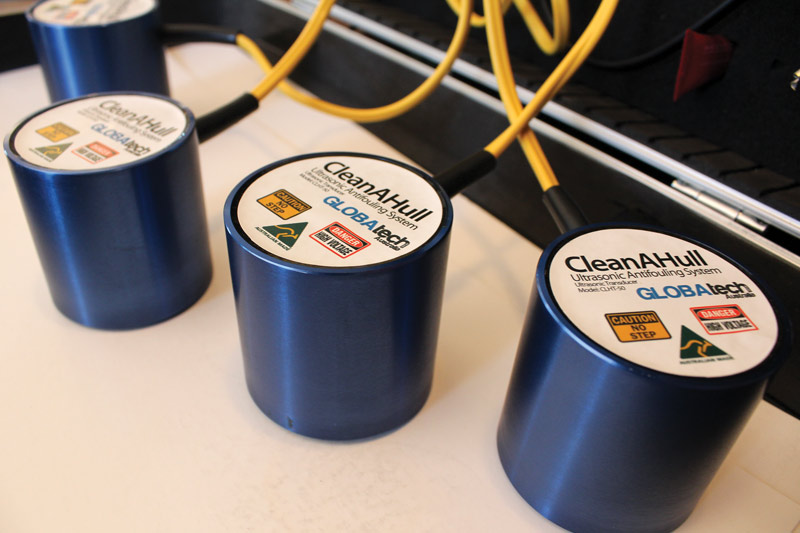“The empty vessel makes the loudest sound.”
—William Shakespeare, Henry V
When you live up to your nose in marine products as I do, you run into a lot of salesmen trying to sell you snake oil. I can’t even begin to list all the revolutionary anchors that are “turning the whole marine industry on its head” or the all-new marine-grade lubricants that are “game changers.” If the salesman has his or her way, the game would be changing daily. Thus, I regard claims that seem too good to be true with a fair, but not unreasonable, amount of caution.
The first time I heard of acoustic antifouling technology, I thought I was hearing the same old sales pitches. Employing sound to kill bottom growth is the basic premise of acoustic antifouling systems. In theory, one only needs to turn the system on and never worry about bottom growth again. As somebody who has lived aboard both in Florida – where bottom growth is so rampant during summer that monthly dives are needed – and the Pacific Northwest, the idea of pushing a button and negating the need for below-water bottom-growth maintenance seemed farfetched. Ultimately, my skepticism was overpowered by my curiosity. The expanding list of testimonials from those who have given acoustic antifouling a shot makes the idea even more compelling. For example, locally-distributed CleanAHull systems (made by GLOBAtech Australia) has happy clients that include the U.S. Coast Guard, U.S. Navy, Alaskan eco-tourism vessels, large motoryachts, and sailboats. Perhaps there is something to these systems after all, I began to think.
When one considers the impending copper bottom paint regulations for Washington, an out-of-the-box solution like acoustic antifouling becomes even more enticing. To get to the bottom it all, I sat down with Tacoma-based Steve Kovach, the Pacific Northwest representative for CleanAHull systems with distributor Ultra-SoniTec, LLC.
Q: Copper bottom paints are still by far the most common mainstream antifouling method. How long has this ultrasonic technology been around for?
Copper has been used, first with sheets and then with paint, for centuries. But during and after WWII, the U.S. Navy noticed that the sonar domes on their submarines were not becoming fouled like the rest of the vessel. They ultimately figured out that the ultrasonic pulses from the sonar system was preventing anything from growing on the dome. So, the principle was discovered during the late ‘40s, and the concept was used on and off without great success.
Not quite 20 years ago, GLOBAtech (an engineering and manufacturing company) decided to go after this technology. GLOBAtech designed and engineered CleanAHull systems for boats, water treatment systems, plumbing systems, and just about anything where growth was a concern. The Australian company can manufacture just about anything. They make their own circuit boards in-house so they don’t send any work out.
Ultra-SoniTec is the United States and Caribbean distributor for CleanAHull systems made by
GLOBAtech Austrailia. With authorized dealers across the country, they are a good place to turn if acoustic antifouling technology has caught your interest. Their headquarters is in Hickory, North Carolina.
ultra-sonitec.com // 828-404-3112
Local Dealer:
Steve Kovach // 253-653-0967

Q: How does the system work, exactly?
One of our standard systems for boats 32′ to 45′ has four ultrasonic transducers involved. Each transducer covers about 50′ of diameter, so we take into consideration the layout every boat for complete coverage. We don’t want to situate transducers near electronics or stringers that may absorb sound, thereby mitigating the transducer’s efficacy. We sell systems in sets of two or four transducers. Ultrasonic antifouling works on fiberglass, steel and aluminum hulls. Wood and ferrocement hulls absorb sound so the system isn’t suitable.
Q: So, every job is basically a custom job?
Sort of, at least in terms of transducer placement and installation. We provide a detailed layout for each installation based on the manufacturer’s drawing or one provided by the boat owner.
Q: The transducers are mounted on the inside of the boat, correct?
Right. Typically, they are close to the middle of the keel. You want some overlap of tthe transducer’s approximately 15 feet of coverage. One boat that we just recently completed is a 76’ motoryacht. It has 16 transducers, one on the bow thruster, one on the stern thruster, one on each stabilizer, one on each rudder and the balance on the hull.
In terms of rudders, we mount transducers on the quadrant or a metal part so the ultrasonic pulses travel downward and disperse around the rudder. Especially in the aft, the sound will be situated around struts to protect those from growth as much as possible. The way these systems work is that the hull is essentially turned into an audio speaker. Sound pulsed at high frequencies are emitted on a cycle, and the pulses extend out a short distance from the hull. The pulses interfere with the cellular structure of microorganisms, killing them. The boat will typically have a grey scum line that’s a millimeter or two thick at the waterline when in its slip. That layer is made up of dead microorganisms killed by the system. As soon as the boat is operating at around three knots or more, the scum washes off.
There’s also the added beneficial effect that there’s nothing on the boat to be eaten by larger lifeforms, because the microscopic basis of the food chain is interrupted. In the case of barnacles, they start out their lives as microscopic larvae, and the acoustic antifouling system neutralizes them before they can mature into a barnacle that grows on a hull.
Q: What about the noise? Can you hear it?
No, it’s completely quiet. You’ll never hear it inside the boat. Divers can hear it when they are near the transducers, and the user can put the system into a sleep mode if desired. We have a sleep mode for three or six hours that we recommend using so that you don’t forget to turn it back on.
Q: Can the system deal with growth that’s already there, or it used purely to keep new growth from happening?
The system does not eliminate old growth. It’s best to install the system on a clean bottom. CleanAHull systems don’t clean a bottom, but it keeps a bottom clean. The systems work in conjunction with paint. We recommend still using a good bottom paint, and most of our customers move to a hard-bottom paint.

Tacoma-based Steve Kovach works as the Pacific Northwest representative for CleanAHull and GLOBAtech products. Kovach has lived in the Pacific Northwest for 30 years and has enjoyed a water-loving lifestyle since his childhood days playing with his friends and family on the Ohio River and Lake Erie. He is an active member of the Tacoma Waterfront Association, has a 100-year-old Old Town Canoe, and races on a Catalina 380.
“I’m a pretty decent trimmer,” says Kovach modestly. He is now looking at mid-sized sailboats that will help him recover from the whirlwind of his daughter’s recent wedding.
Q: Do these systems increase the amount of time a boater can operate before a haul out?
Yes, that is one of the best attributes of ultrasonic antifouling methods. Our customers in the Pacific Northwest have shifted from needing a haul-out and new bottom paint every 18 to 24 months to a three- or four-year cycle. That’s some considerable savings!
For example, our company headquarters is in North Carolina and we have a company office in Sarasota, Florida as well. The owner of the company has a 58′ Hatteras in Sarasota. Florida is a very active area for growth, and Sarasota Bay is a mix of fresh and saltwater. During the summer months, he hired a diver twice a month. He used to haul out his boat every 18 months or less, and his haul-outs cost him about $7,000 a time.
Then he went ultrasonic. The system on his boat cost $8,000 and paid for itself after 13 months. He is going three years now between haul-outs. For a system of eight, the price is about $5,000. The standard quad system is about $2,500. Many of our customers install themselves, we have installation instructions, online videos, and the like. It’s quite easy. There is an upfront cost on these systems, but by far, everyone we sell this to has saved money in the long term. It’s a cost saver.
Q: What about environmental impacts?
This system is completely non-invasive to the marine environment, and no chemicals are involved. We always get the question about oxidation as well, and ultrasonic antifouling methods have nothing to do with replacing zincs and the like. The pulses of sound have no effect on electrolysis or galvanic corrosion. And there’s nothing in the water, no through holes are even needed.
We get questions about sea mammals too, and it doesn’t effect sea mammals. Even though it is a high-frequency sound pulse, the sound only extends a few millimeters beyond the boat. Our clients have dolphins and the like following the wakes of their boats just like normal.
Some people turn it off when underway, which makes sense. You don’t have to worry about growth generally when underway. But you certainly don’t want to forget to turn it on again when you’re in port. The power draw on an entire standard quad-transducer system is 850 milliamps (mA). It’s basically an anchor light with regards to power draw. When you’re at dock, it won’t add much of anything to the shore power bill.
We’ve also been rated the highest place for an eco-friendly antifouling system by the Northwest Green Chemistry Association, which took place last year or the year before. From an ecological standpoint, we’re off the charts in terms of being good for the environment.
Q: Could you put a unit like this on a marina dock to keep it growth-free?
We had a question about that recently. It could work, technically. We haven’t had anybody actually try that. You’d have to have a special unit that is submersible. The transducers we sell to boaters are submersible up to three feet or so and engineered with U.S. marine grade waterproof approval, number 68 or 69. Highly tested. Our understanding is that ours is the highest rated in terms of being waterproof.
Q: What kind of safety features do your systems feature? How does one know if the system is working properly? Are there safety features to keep users in the know?
Our control module constantly measures the temperature inside the model, the electric pulses, and other parameters. What’s more, our transducers have separate generators, while other models run all transducers on the same generator. That’s good in case of failure. We’ve never had a generator fail, knock on wood.
Our system also automatically adjusts for a 12-Volt or 24-Volt power system. There are smart electronics in it that display alarms and notifications. For example, if a transducer fails, then a red light will flash, and an audio alarm will go off so you can address the situation.
We had a customer who got an alarm once, and we actually downloaded the data directly from the system to our engineering support team to figure out what was going on. In this case, there was chaffing of a wire from a transducer installed in the bilge that the owner didn’t catch right away.
Q: A lot of electronics systems are moving toward the Wi-Fi compatible and NMEA 2000 gateway direction. Is that the plan here? Is it necessary?
It’s not really necessary for us. Fundamentally, it’s a passive part of the boat. It’s always there and it’s always running. If there’s an alarm, you’re going to know it.